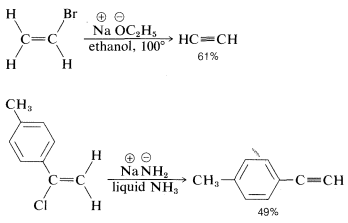


 علم الكيمياء
علم الكيمياء 
 الكيمياء التحليلية
الكيمياء التحليلية 
 الكيمياء الحياتية
الكيمياء الحياتية 
 الكيمياء العضوية
الكيمياء العضوية 
 الكيمياء الفيزيائية
الكيمياء الفيزيائية
 الكيمياء اللاعضوية
الكيمياء اللاعضوية 
 مواضيع اخرى في الكيمياء
مواضيع اخرى في الكيمياء
 الكيمياء الصناعية
الكيمياء الصناعية |
أقرأ أيضاً
التاريخ: 29-7-2018
التاريخ: 7-10-2020
التاريخ: 10-1-2022
التاريخ: 25-8-2019
|
Structural influences on E2 reactions have been studied in some detail. Like the competing SN2 process, a good leaving group is necessary and of these, the most commonly used are the halides, Cl, Br, and I; sulfonate esters, RS(O2)O−; and -onium ions such as ammonium, ⊕NR4, and sulfonium, ⊕SR3:

Rather strong bases generally are required to bring about the E2 reaction. The effectiveness of a series of bases generally parallels their base strengths, and the order ⊖NH2 > ⊖OC2H5 > ⊖OH > ⊖OCCH3 is observed for E2 reactions. This fact is important in planning practical syntheses, because the E2 reaction tends to predominate with strongly basic, slightly polarizable reagents such as amide ion, ⊖NH2, or ethoxide ion, ⊖OC2H5. In contrast, SN2 reactions tend to be favored with weakly basic nucleophiles such as iodide ion or ethanoate ion (unless dipolar aprotic solvents are used, which may markedly change the reactivity of anionic nucleophiles).
As for the alkyl group, there are two important structural effects to notice. First, at least one C−H bond adjacent (β) to the leaving group is required. Second, the ease of E2 elimination follows the order tertiary R > secondary R > primary R. Unlike SN2 reactions, which are not observed for tertiary alkyl compounds because of steric hindrance to the approach of the nucleophile to carbon, the related E2 reaction usually occurs readily with tertiary RX compounds. The reason is that little or no steric hindrance is likely for the approach of a base to a hydrogen unless the base is exceptionally bulky:

The reactivity order also appears to correlate with the C−X bond energy, inasmuch as the tertiary alkyl halides both are more reactive and have weaker carbon-halogen bonds than either primary or secondary halides. In fact, elimination of HX from haloalkenes or haloarenes with relatively strong C−X bonds, such as chloroethene or chlorobenzene, is much less facile than for haloalkanes. Nonetheless, elimination does occur under the right conditions and constitutes one of the most useful general methods for the synthesis of alkynes. For example,

The conditions and reagents used for E2 and SN2 reactions are similar enough that it is difficult to have one occur without the other. However, E2 elimination is favored over SN2 substitution by (a) strongly basic nucleophiles, (b) bulky nucleophiles, and (c) increasing alkyl substitution at the α carbon. It also is observed that increasing the reaction temperature generally leads to an increase in elimination at the expense of substitution. In fact, surprisingly good yields of alkene or alkyne can be obtained by adding a halogen compound directly to molten or very hot KOH with no solvent present, whereupon the product is formed rapidly and distills immediately from the hot reaction mixture:




|
|
|
|
التوتر والسرطان.. علماء يحذرون من "صلة خطيرة"
|
|
|
|
|
|
|
مرآة السيارة: مدى دقة عكسها للصورة الصحيحة
|
|
|
|
|
|
|
نحو شراكة وطنية متكاملة.. الأمين العام للعتبة الحسينية يبحث مع وكيل وزارة الخارجية آفاق التعاون المؤسسي
|
|
|